Woodblock prints of ages past show giant octopuses ripping apart boats and feasting on sailors like popcorn. These artifacts of ancient sea-lore make for rousing images, but they are quite wrong: octopuses are fierce and cunning hunters but they present little danger to humans—with a noteworthy exception. The truly dangerous octopuses are not giant monsters (perhaps the artists of yesteryear were thinking of the mighty giant squid?) but rather tiny jewel-like beauties from the genus Hapalochlaena which includes only three or four species. Known as blue-ring octopuses the tiny creatures swim in tide pools and shallows of the Indo-Pacific Ocean from Japan down to Australia (where they are most prevalent). Blue-ringed octopuses live on shrimp, crabs, minnows, and horseshoe crabs. They are tremendous hunters who use camouflage, stealth, and guile to catch their prey. However, these tools pale before their greatest weapon: the little octopuses are among the most poisonous creatures on planet Earth.
Like the flamboyant cuttlefish, the blue-ringed octopus does not like to bite without giving warning but advertises its toxicity with vivid coloration. The octopus can conceal itself with tremendous prowess however, as soon as it becomes aware of a predator or some other threat, it dials up its coloration changing from muted reef tones to brilliant yellow with iridescent blue rings. If you see something like this in the ocean, for heaven’s sake don’t touch it. The octopus’s warning colors let ocean predators know to leave it alone but immediately attract humankind’s magpie urge to grab shiny things. Although blue-ringed octopuses are good natured and have been known not to bite people who were provoking them rather intensely, their bites have caused more than seventy recorded fatalities in Australia. The octopus has a tiny beak and often a victim does not realize they have been bitten until they began to fall into paralysis and their respiration starts to fail.
The venom of the blue ringed octopus is a complicated pharmacological cocktail which includes tetrodotoxin, 5-hydroxytryptamine, hyaluronidase, tyramine, histamine, tryptamine, octopamine, taurine, acetylcholine, and dopamine. The most active ingredient tetrodotoxin blocks the sodium channels which conducting sodium ions (Na+) through a cell’s plasma membrane. This causes total paralysis for the octopus victim, however if clever and persistent rescuers are present at the time of the bite they can rescue the unfortunate soul with continuous artificial respiration. This is no small matter as bite victims are often rendered completely unresponsive by the paralytic victim. Although completely conscious they are unable to communicate in any way or even breathe. If artificial respiration is initiated immediately and continued until the body can metabolize and eliminate the toxin, bite victims can survive (although it sounds like rather an ordeal).
Blue ringed octopuses are tender and solicitous mothers. The mother octopus lays a clutch of approximately 50 eggs in autumn which she incubates beneath her arms for about six months (during which time she is unable to eat). When the eggs hatch, the mother octopus dies. The baby octopuses reach sexual maturity in about a year. Despite their cleverness and beauty, the animals are as ephemeral as they are deadly.

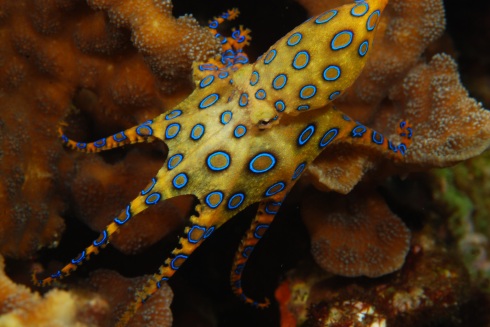
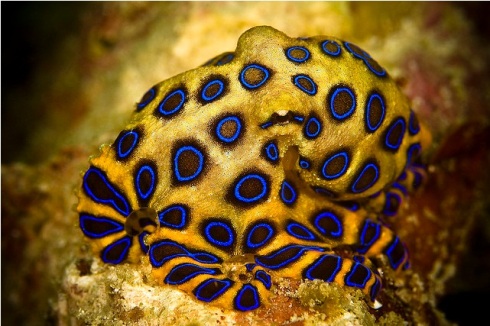
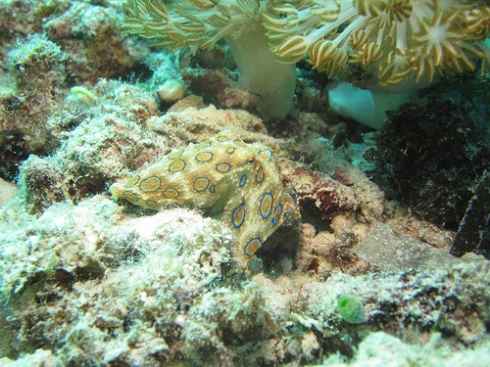
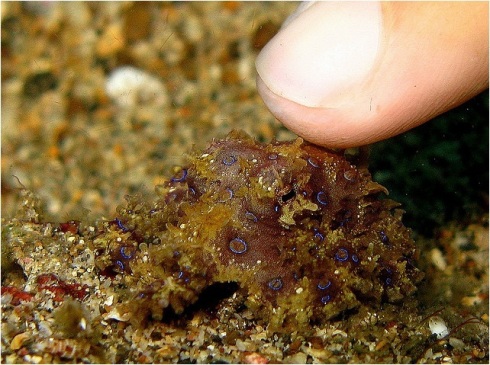
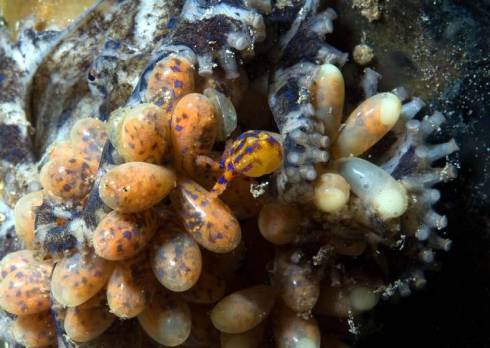
5 comments
Comments feed for this article
February 13, 2013 at 11:52 PM
izabella
hi
February 13, 2013 at 11:53 PM
izabella
that is cool
February 14, 2013 at 11:40 AM
Wayne
Thanks, izabella!
April 14, 2013 at 10:11 PM
remi
hi what do baby blue ringed octopus eat?
April 22, 2013 at 4:57 PM
Wayne
I imagine they eat pretty much any invertebrate they can fit in their mouth–things like crustacean larvae, copepods, and the like…